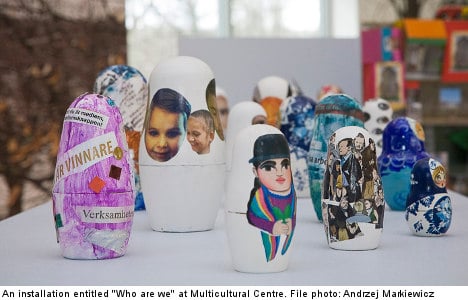Why is it that the notion lives on about what a Swedish appearance looks like? The radio programme Studio 1 asked this question in March during a debate about racism in Sweden today. The question of Swedishness is a loaded one and the debate heats up when race becomes an ever-more central concept in order to understand racist practices in every-day life in Sweden.
Our thoughts and our actions are affected by history and by society’s structures and norms. Society and its different shapes existed before each and every one of us alive today were born. In other words, we are born into a web of thought patterns and values that influence how we treat and regard each other and ourselves. We are quite simply greatly affected by structural power hierarchies that came about during a period in history marked by racism and colonialism. Of course there is development over time, but when it comes to norms and stereotypes it takes a long time.
Swedes do not stand apart from the world and its history of racism and colonialism. Our way of dealing with this has so far been to deny that race exists, while we have also wanted to affirm the unknown and the new. Most Swedes will claim they are colour blind, and only see a human before them when they meet someone new. This denial risks hiding from view the discrimination and the segregation that is so tangible and evident for the many who are not seen as Swedes, and whose stories make up a painful testament to the state of things in Sweden.
Several articles and debates have recently criticized Multicultural Centre’s exhibition Warning For Race and our anthology Race And Whiteness In Contemporary Sweden. We have read twenty-odd texts that object to our choice to use the term race. We know that the word race is taboo today, but at the same time it is related to a history that we still have not managed to come to terms with.
Critics say we are trying “fight fire with fire”, as a Svenska Dagbladet (SvD) editorial writer put it, or they say speaking about race doesn’t lead anywhere in attempts to understand today’s Sweden. What the criticisms has in common is that they strongly argue for how things should be – that race should not have any significance in today’s Sweden – instead of looking at what they actually look like.
That is why we argue that Sweden needs a non-colour-blind anti-racism that enables an understanding of the thought structures behind today’s exclusive Swedishness. That is what we are trying to talk about and what we intend the exhibition Warning For Race to contribute to.
Like most other people, we do not believe that separating people into race would solve any social problems. But if certain groups of people with similar backgrounds are found over and over in the lower tiers of the statistics tables, then there is a reason to seek out knowledge about it and try to understand what the consequences are.
The reason Multicultural Centre raises the concept of race is because we still think race is an active category in Sweden, or, as we say in the exhibit, “race is still done” all the time in today’s Sweden even though the concept itself has been discarded by science and politics alike.
We still separate people based on what they look like. Not always and not everywhere, but it is happening all the more often and in particular in relation to who is regarded as being Swedish or not. It happens in the media, it happens in culture.
There is even solid empirical research about Swedish every-day racism that has chronicled the experiences of non-white Swedes. It does not make for fun reading.
For the past 15 years, we at Multicultural Centre have studied and worked with the phenomenon of every-day racism in an educational manner. From there, we have concluded that we need to speak about race, instead of just contenting ourselves with analyses of ethnicity, meetings between cultures, and general xenophobia.
Despite most Swedes today distancing themselves from racism, we still meet stereotypical images and descriptions of non-white minorities and non-Western cultures in contemporary Swedish culture. Comparatively, Sweden has established some of the strongest laws against discrimination, and therefore gets top grades in the Migrant Integration Policy Index for creating the best preconditions for integration of new citizens. This isn’t what needs improving.
We see a segmented labour market, and we see housing segregation – even when we compare with other countries that are much more cautious towards people who are not seen to belong to the majority population.
Taken together, this should prompt us to pause for reflection.
We want a new Swedish story better equipped to deal with and include today’s demographic diversity and to create a new Swedishness for the future. That new story’s main task is to separate whiteness from Swedishness in order to be a socially sustainable future Swedishness.
To find our way to that story, we think we must make visible the suppression and discrimination based on appearance, which we do in the exhibit and in the anthology. Let us not pretend that Sweden and Swedes stand apart from the world, history and the racial thinking and the norm of whiteness that still live on both in other countries and in our own society.
Christina Zedell, Willy Viitala, Leif Magnusson and Tobias Hübinette of the Multicultural Centre, which was established as a foundation by Botkyrka Municipality in 1987.
This article was originally published on the Newsmill citizen op-ed site.



 Please whitelist us to continue reading.
Please whitelist us to continue reading.
Member comments